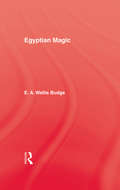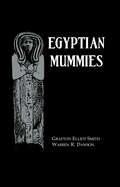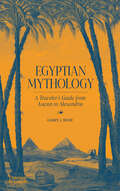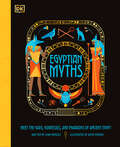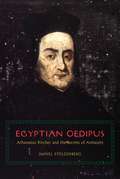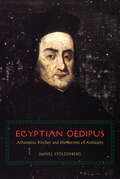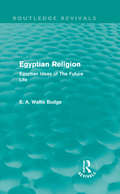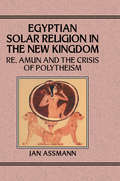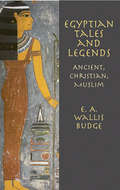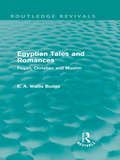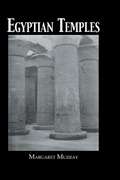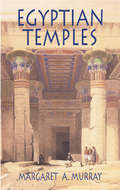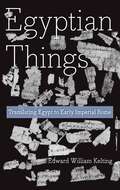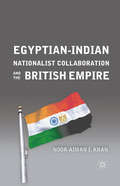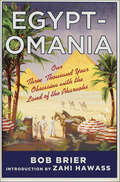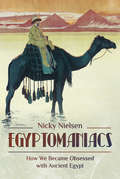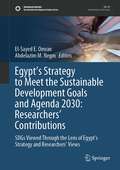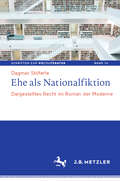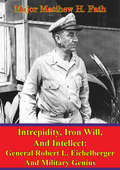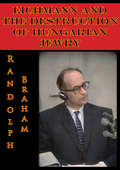- Table View
- List View
Egyptian Magic (Egypt Ser.)
by E. A. Wallis BudgeFirst published in 2002. Routledge is an imprint of Taylor & Francis, an informa company.
Egyptian Mummies
by Grafton Elliot Smith Warren R. DawsonFirst published in 2002. Routledge is an imprint of Taylor & Francis, an informa company.
Egyptian Mummies: Made to Last (Fountas & Pinnell Classroom, Guided Reading)
by Jill RubalcabaNIMAC-sourced textbook. Preserving the Dead. Jackals dug them up and gnawed on them. Bacteria rotted them. Yet many bodies of ancient Egyptians still survive today.
Egyptian Mythology
by F. Max MüllerThe complexities of Egyptian mythology — its gods, sun and animal worship, myths, and magical practices — are explored. The development of religious doctrines, as portrayed in art and in literature, also receives a close inspection. Magnificently illustrated, the text contains 232 figures that clarify ancient beliefs and customs.
Egyptian Mythology: A Traveler's Guide from Aswan to Alexandria
by Garry J. ShawThis unique approach to Egyptian mythology takes readers on a tour up the Nile, stopping at the most famous monuments and vividly retelling the myths connected to each site. Join Egyptologist Garry J. Shaw on an entertaining tour up the Nile, through a beautiful and fascinating landscape populated with a rich mythology: the stories of Horus, Isis, Osiris, and their enemies and allies in tales of vengeance, tragedy, and fantastic metamorphoses. Shaw retells these stories with his characteristic wit, and reconnects them to the temples and monuments that still stand today, offering a fresh look at the most visited sites of Egypt. The myths of ancient Egypt have survived in fragments of ancient hymns and paintings on the walls of tombs and temples, spells inked across coffins, and stories scrawled upon scrolls. Illustrations throughout bring to life the creation of the world and the nebulous netherworld; the complicated relationships between fickle gods, powerful magicians, and pharaohs; and eternal battles on a cosmic scale. Shaw’s evocative descriptions of the ancient ruins will transport readers to another landscape—including the magnificent sites of Dendera, Tell el-Amarna, Edfu, and Thebes. At each site, they will discover which gods or goddesses were worshipped there, as well as the myths and stories that formed the backdrop to the rituals and customs of everyday life. Each chapter ends with a potted history of the site, as well as tips for visiting the ruins today. Egyptian Mythology is the perfect companion to the myths of Egypt and the gods and goddesses that shaped its ancient landscape.
Egyptian Myths
by Jean MenziesA beautifully illustrated collection of 20 ancient Egyptian myths retold for children aged 7-9.Delve into a world of monstrous creatures, magical spells, and warring gods in this thrilling compendium of ancient Egyptian myths. With 20 exciting tales alongside fascinating historical information, this is a must-have introduction for young readers interested in one of the world&’s great early civilizations. From the creation of the world to the first pharaohs, this book charts the full sweep of ancient Egyptian mythology, revealing fascinating elements of culture and religion along the way. The enthralling stories introduce mighty gods and wicked villains, while a handy reference section is packed with information about the ancient Egyptians themselves. Learn how Ra fought daily battles to make the Sun rise, how trouble-making Set brought chaos to the kingdom, and how Osiris became the first mummy. Perfect for children aged 7 to 9, this collection contains more than 20 enthralling new retellings of favorite myths as well as some you might not have heard before.Encourage your children to explore: Over 20 fascinating Egyptian myths, covering famous classics and lesser known storiesStriking illustrations by multi-award winning artist Katie PonderStunning gold foil on the cover A handy pronunciation guide listing all difficult-to-pronounce names for the reader&’s convenienceKey reference spreads combining the appeal of a story collection with key reference informationIt&’s time to dive into the Duat underworld, ride into the sky on the back of the heavenly cow, and discover the secrets of the pharaoh&’s tombs. Egyptian Myths brings the world of ancient Egypt to life and is the perfect gift for children who love history and mythology. At DK, we believe in the power of discovery. So why not complete the collection!Discover stories from Ancient Greece like never before with Greek Myths, and uncover action-packed tales of extraordinary creatures and compelling gods, goddesses and more with Norse Myths.
Egyptian Oedipus: Athanasius Kircher and the Secrets of Antiquity
by Daniel StolzenbergA contemporary of Descartes and Newton, Athanasius Kircher, S. J. (1601/2-80), was one of Europe's most inventive and versatile scholars in the baroque era. He published more than thirty works in fields as diverse as astronomy, magnetism, cryptology, numerology, geology, and music. But Kircher is most famous--or infamous--for his quixotic attempt to decipher the Egyptian hieroglyphs and reconstruct the ancient traditions they encoded. In 1655, after more than two decades of toil, Kircher published his solution to the hieroglyphs, Oedipus Aegyptiacus, a work that has been called "one of the most learned monstrosities of all times. " Here Daniel Stolzenberg presents a new interpretation of Kircher's hieroglyphic studies, placing them in the context of seventeenth-century scholarship on paganism and Oriental languages. Situating Kircher in the social world of baroque Rome, with its scholars, artists, patrons, and censors, Stolzenberg shows how Kircher's study of ancient paganism depended on the circulation of texts, artifacts, and people between Christian and Islamic civilizations. Along with other participants in the rise of Oriental studies, Kircher aimed to revolutionize the study of the past by mastering Near Eastern languages and recovering ancient manuscripts hidden away in the legendary libraries of Cairo and Damascus. The spectacular flaws of his scholarship have fostered an image of Kircher as an eccentric anachronism, a throwback to the Renaissance hermetic tradition. Stolzenberg argues against this view, showing how Kircher embodied essential tensions of a pivotal phase in European intellectual history, when pre-Enlightenment scholars pioneered modern empirical methods of studying the past while still working within traditional frameworks, such as biblical history and beliefs about magic and esoteric wisdom.
Egyptian Oedipus: Athanasius Kircher and the Secrets of Antiquity
by Daniel StolzenbergA contemporary of Descartes and Newton, Athanasius Kircher, S. J. (1601/2–80), was one of Europe’s most inventive and versatile scholars in the baroque era. He published more than thirty works in fields as diverse as astronomy, magnetism, cryptology, numerology, geology, and music. But Kircher is most famous—or infamous—for his quixotic attempt to decipher the Egyptian hieroglyphs and reconstruct the ancient traditions they encoded. In 1655, after more than two decades of toil, Kircher published his solution to the hieroglyphs, Oedipus Aegyptiacus, a work that has been called “one of the most learned monstrosities of all times.” Here Daniel Stolzenberg presents a new interpretation of Kircher’s hieroglyphic studies, placing them in the context of seventeenth-century scholarship on paganism and Oriental languages. Situating Kircher in the social world of baroque Rome, with its scholars, artists, patrons, and censors, Stolzenberg shows how Kircher’s study of ancient paganism depended on the circulation of texts, artifacts, and people between Christian and Islamic civilizations. Along with other participants in the rise of Oriental studies, Kircher aimed to revolutionize the study of the past by mastering Near Eastern languages and recovering ancient manuscripts hidden away in the legendary libraries of Cairo and Damascus. The spectacular flaws of his scholarship have fostered an image of Kircher as an eccentric anachronism, a throwback to the Renaissance hermetic tradition. Stolzenberg argues against this view, showing how Kircher embodied essential tensions of a pivotal phase in European intellectual history, when pre-Enlightenment scholars pioneered modern empirical methods of studying the past while still working within traditional frameworks, such as biblical history and beliefs about magic and esoteric wisdom.
Egyptian Religion: Egyptian Ideas of The Future Life (Routledge Revivals)
by E.A. Wallis BudgeSir E. A. Wallis Budge (1857-1934) was Keeper of the British Museum’s department of oriental antiquities from 1894 until his retirement in 1924. Carrying out many missions to Egypt in search of ancient objects, Budge was hugely successful in collecting papyri, statues and other artefacts for the trustees of the British Museum: numbering into the thousands and of great cultural and historical significance. Budge published well over 100 monographs, which shaped the development of future scholarship and are still of great academic value today, dealing with subjects such as Egyptian religion, history and literature. First published in 1899 as part of the Egypt and Chaldaea series, Egyptian Religion explores the principal ideas and beliefs held by the ancient Egyptians with regard to the doctrine of the resurrection and the future life. Although no systematic account dealing solely with this doctrine has been discovered, the Book of the Dead and various other religious texts from which this work is derived reflect ancient Egyptian beliefs, ideals and superstitions. Wallis Budge explores the Gods of the Egyptians and the themes of resurrection and immorality in a classic work, of great significance to students and scholars with an interest in ancient Egyptian and Middle Eastern history and religion.
Egyptian Society Under Ottoman Rule, 1517-1798
by Michael WinterMichael Winter's book presents a panoramic view of Ottoman Egypt from the overthrow of the Mamluk Sultanate in 1517 to Bonaparte's invasion of 1798 and the beginning of Egypt's modern period. Drawing on archive material, chronicle and travel accounts from Turkish, Arabic, Hebrew and European sources as well as up-to-date research, this comprehensive social history looks at the dynamics of the Egyptian-Ottoman relationship and the ethnic and cultural clashes which characterised the period. The conflicts between Ottoman pashas and their Egyptian subjects and between Bedouin Arabs and the more sedentary population are presented, as is the role of women in this period and the importance of the doctrinal clash of Islam both orthodox and popular, Christianity and Judaism. Winter's broad survey of a complex and dynamic society draws out the central theme of the emergence, from a period of ethnic and religious tension, of an Egyptian consciousness fundamental to Egypt's later development.
Egyptian Solar Religion
by AssmannRevised and expanded, this volume deals with the religious traditions of ancient Egypt, which have come down to us in a state which is both extremely fragmentary and complex. New material - especially hymns collected in Theban tombs - now allows a much more precise allocation of religious texts and ideas in terms of time, place and social context. Within the field of solar religion, no less than five different traditions have to be distinguished: 1) the liturgical traditions of the royal solar cult, which for their secrecy and exclusivity are labelled the "mysteries" of the sun cult; 2) the traditional mythology of the solar course expressed in hymns and pictorial representations; 3) the revolutionary process culminating in the Amarna period, which discards the mythic images and gives a monotheistic construction of the solar course, a process which starts before Akhenaten's revolution; 4) the theology of Amun-Re, the God of Thebes, before the Amarna Period, a theology of primacy where one god acts as chief of a pantheon; and 5) the quite different theology of this same Amun-Re after Amarna, a theology which answers the monotheistic experience by developing a kind of pantheism - the concept of the hidden god - who is both cosmic god and personal saviour.
Egyptian Tales and Legends: Ancient, Christian, Muslim
by E.A. Wallis BudgeSpanning the early dynastic period to modern times, treasury of Egyptian folklore encompasses 36 beguiling stories. First part contains tales originally written in hieratic characters; second part documents Christian influence; third part recounts stories of Muslims who succeeded Copts. 40 black-and-white illustrations.
Egyptian Tales and Romances: Pagan, Christian and Muslim (Routledge Revivals)
by E. A. BudgeSir E. A. Wallis Budge (1857-1934) was Keeper of the British Museum’s department of oriental antiquities from 1894 until his retirement in 1924. Carrying out many missions to Egypt in search of ancient objects, Budge was hugely successful in collecting papyri, statues and other artefacts for the trustees of the British Museum: numbering into the thousands and of great cultural and historical significance. Budge published well over 100 monographs, which shaped the development of future scholarship and are still of great academic value today, dealing with subjects such as Egyptian religion, history and literature. First published in 1931, Egyptian Tales and Romances examines the historical and religious romances of the Egyptians from the early dynastic period to the twentieth century. Budge demonstrates Egypt’s transition from Paganism to Christianity, and finally to Islam, through tales and stories carefully transcribed and translated. Part I contains historical romances written on papyrus and stone, whilst parts II and III are derived largely from Coptic and Muslim manuscript sources. Including detailed illustrations and photographs, this fascinating classic work will be of interest to academics and students of Egyptian folklore, archaeology and history, as well as the general inquisitive reader.
Egyptian Temple (Egypt Ser.)
by Margaret MurrayFirst published in 1984. Routledge is an imprint of Taylor & Francis, an informa company.
Egyptian Temples
by Margaret A. MurraySurvey of the architectural styles and histories of Egyptian temples built thousands of years ago. Over 120 photographs and diagrams depict exteriors, interiors of many sacred structures, including the ruins of the Temple of the Sphinx, and the remarkable structures at Karnak; the Temple of Luxor; the great temples at Abu Simbel; more.
Egyptian Temples (Egypt Ser.)
by MurrayFirst published in 2005. Routledge is an imprint of Taylor & Francis, an informa company.
Egyptian Things: Translating Egypt to Early Imperial Rome
by Edward William KeltingA free ebook version of this title is available through Luminos, University of California Press’s Open Access publishing program. Visit www.luminosoa.org to learn more. After the deaths of Antony and Cleopatra, Rome finally took control of Egypt. This occupation simultaneously facilitated and circumscribed the exchange of goods, people, and ideas along the paths carved across Rome’s burgeoning empire. In this book, Edward Kelting sets out to recapture one of these systems of exchange: the vibrant literary tradition known as Aegyptiaca—or "Egyptian things"—in which culturally mixed authors wrote about Egypt for a Greek and Roman audience. These authors have been dismissed as not really "Egyptian," and their contemporary popularity has been ignored. But as Kelting powerfully argues, this genre in fact constitutes a vibrant intellectual tradition, developed from heterogeneous influences but deeply engaged with Egypt’s pharaonic past. In contrast to usual narratives of Roman domination, Kelting uncovers a complex project of political engagement and cultural translation in which Egyptians, Greeks, and Romans all participated.
Egyptian-Indian Nationalist Collaboration and the British Empire
by Noor-Aiman I. KhanAn examination of the collaboration between Egyptian and Indian nationalists against the British Empire, this book argues that the basis for Third World or Non-Aligned Movement was formed long before the Cold War.
Egyptomania: Our Three-Thousand Year Obsession with the Land of the Pharaohs
by Bob Brier“A delightful romp through key formative events that shaped our popular passion for all things ancient Egyptian.” —Peter Der Manuelian, Professor of Egyptology, Harvard UniversityWhen the Romans conquered Egypt, it was really Egypt that conquered the Romans. Cleopatra captivated both Caesar and Marc Antony and soon Roman ladies were worshipping Isis and wearing vials of Nile water around their necks. In this book, renowned Egyptologist Bob Brierexplores our three-thousand-year-old fascination with all things Egyptian—from ancient times to Napoleon’s Egypt Campaign, the discovery of Tutankhamen’s tomb, and beyond.In this original and groundbreaking book, Brier traces our fascination with mummies that seem to have cheated death and the iconic pyramids that have stood strong for millennia. He also includes twenty-four pages of color photos from his impressive collection of Egyptian memorabilia, which includes everything from Napoleon’s twenty volume Egypt encyclopedia to archeologist Howard Carter’s letters written as he was excavating the Valley of the Kings.
Egyptomaniacs: How We Became Obsessed with Ancient Epypt
by Nicky NielsenAn examination of the popular view of ancient Egypt as an exotic, esoteric, and mystical culture that questions if that view is entirely accurate.The Greek historian Hecataeus of Abdera declared during the 4th century BCE that the Egyptian civilization was unsurpassed in the arts and in good governance, surpassing even that of the Greeks. During the Renaissance, several ecclesiastical nobles, including the Borgia Pope Alexander VI claimed their descent from the Egyptian god Osiris. In the 1920s, the discovery of Tutankhamun’s tomb in the Valley of the Kings prompted one of the first true media frenzies in history. For thousands of years, the Pharaonic culture has been a source of almost endless fascination and obsession. But to what extent is the popular view of ancient Egypt at all accurate?In Egyptomaniacs: How We Became Obsessed With Ancient Egypt, Egyptologist Dr. Nicky Nielsen examines the popular view of Egypt as an exotic, esoteric, mystical culture obsessed with death and overflowing with mummies and pyramids. The book traces our obsession with ancient Egypt throughout history and methodically investigates, explains and strips away some of the most popular misconceptions about the Pharaohs and their civilization.Praise for Egyptomaniacs“I have always been attracted to and fascinated by Ancient Egypt. In this superb book, Nicky Nielsen explains why we are so caught up in what happened in Ancient Egypt.” —Books Monthly (UK)
Egypt’s Strategy to Meet the Sustainable Development Goals and Agenda 2030: Sdgs Viewed Through The Lens Of Egypt's Strategy And Researchers' Views (Sustainable Development Goals Series)
by Abdelazim M. Negm El-Sayed E. Omran<p>This book focuses on Egypt as a representative example of emerging economies struggling to achieve their sustainable development goals (SDGs). The Egyptian government has launched Egypt’s Vision 2030 in line with the 2030 Agenda, also known as the Sustainable Development Strategy (SDS), which encompasses the economic, social and environmental dimensions of development. It is under the SDS that all development plans in Egypt are incorporated while at the same time being strongly guided by the SDGs. Aware of the principle of shared but differentiated responsibility, Egypt also recognizes that fundamental challenges remain, despite a strong willingness to achieve the SDGs. High birth rates, brain drain phenomena, water scarcity, migration, discrimination against women and girls, a growing informal sector and instability in neighboring states (especially Libya and Syria) are only some of the many hindrances to sustainable development.<p> <p>In order to address these challenges, Egypt relies heavily on the SDGs, which are aimed at transforming our world. Although there is an urgent need for a drastic change in the way we use the Earth, the question arises as to whether the SDGs are sufficient to facilitate such a transformation. This book explores the key environmentally related Sustainable Development Goals (SDGs) and offers a cutting-edge assessment of current progress with a view to reaching these objectives by 2030. The book highlights some of the key findings and ideas for how research may help achieve the 17 Sustainable Development Goals in enterprises. The book provides a useful framework that can help and aid the Egyptian government to assess the many goals and targets outlined in the 2030 Agenda. The analysis of Egypt can be used as a blueprint for other developing nations and globally in order to guide policy toward achieving the SDGs. Covering food security, water resilience, climate change, agronomics, rural life, environmental impact assessment as a tool for measuring the achievement of the goals, Egyptian education, the COVID-19 pandemic, cultural and societal dimensions, this book will be of great interest to students and scholars of sustainable development and climate change, as well as practitioners and policymakers involved in sustainable development and disaster management.<p>
Ehe als Nationalfiktion: Dargestelltes Recht im Roman der Moderne (Schriften zur Weltliteratur/Studies on World Literature #10)
by Dagmar StöferleEs gibt eine Vorgeschichte des Ehebruchromans, der in der zweiten Hälfte des 19. Jahrhunderts zu einem gesamteuropäischen literarischen Paradigma wurde. Im Zuge der Französischen Revolution entsteht eine säkulare Ehegesetzgebung, die einen metaphorischen Überschuss produziert, der bis heute wirksam ist. Das Buch zeichnet rechtshistorisch und anhand kanonischer literarischer Texte von Rousseau über Goethe und Manzoni bis hin zu Hugo und Flaubert nach, wie die Ehe um 1800 zu einer Reflexionsfigur für den modernen Nationalstaat werden konnte. Dabei entstehen originelle Beiträge zur Philologie der einzelnen Texte. Zugleich werden Recht und Literatur für eine historische Semantik von Gesellschaft und Gemeinschaft fruchtbar gemacht.
Eichelberger - Intrepidity, Iron Will, And Intellect: General Robert L. Eichelberger And Military Genius
by Major Matthew H. FathThere are currently two contradictory schools of thought in the historiography of General Robert L. Eichelberger's generalship. One group of authors, John Shortal and Jay Luvaas, consider Eichelberger a brilliant World War II commander. Another author, Paul Chwialkowski, believes Eichelberger to be good, but not distinguished. This study attempts to develop a concise judgment of Eichelberger's leadership. The research analyzed Eichelberger's generalship using Clausewitz's theory of military genius as a model. The first step was to define military genius and to determine its components and subcomponents. Next, Eichelberger's pre-World War II education, mentorship, and training experiences were evaluated. The third step was to analyze Eichelberger's generalship during the Papua New Guinea, Netherlands New Guinea, and Philippines Campaigns of World War II to determine if he consistently demonstrated the qualities of military genius. This study concluded that Eichelberger definitively displayed the components of courage and determination but a judgment on his coup d'œil required a more detailed examination and warranted further research. Eichelberger's leadership is relevant to today's military officer because he successfully defeated an enemy who employed many asymmetrical tactics of potential enemies in the contemporary operating environment: anti-access denial, defense in complex terrain, and fanatical fighting abilities.
Eichelberger In Mindanao: Leadership In Joint Operations
by LTC Dan K. McNeillGeneral Robert L. Eichelberger was an extraordinary and brilliant leader. He was a selfless man who loyally and diligently served an egocentric task maker in General Douglas MacArthur. Eichelberger was the American version of the British Field Marshal William Slim of Burma fame. In a six-month period in World War II, Eichelberger's Eighth US Army made 52 amphibious landings in the Southwest Pacific Theater. In each of those operations, Eichelberger skillfully used US and Allied ground troops, naval forces, and aircraft. While his Army was normally assigned a supporting or mopping-up role, the Mindanao campaign was solely Eichelberger's. The purpose behind this study is to explore Eichelberger's leadership in the joint operations on, Mindanao Island in the Philippines.
Eichmann And The Destruction Of Hungarian Jewry
by Randolph L. BrahamThe capture of Adolf Eichmann and the subsequent dispute between Israel and Argentina before the Security Council of the United Nations have aroused new interest in the history of Nazi Germany in general and of its anti-Jewish policies in particular. This interest gained momentum as the preparations for Eichmann's trial progressed.The 15 years that have elapsed since the end of World War II have brought to light a plethora of new material and made possible a more objective evaluation of the Nazi design to liquidate the Jews of Europe, euphemistically referred to as "the final solution of the Jewish question."This study has a modest aim. Its primary purpose is to present a succinct, though informative, account of the destruction of the Hungarian Jewish community during World War II, with special emphasis on the role of Eichmann and his collaborators. Its scope and coverage are limited, for, indeed, volumes would be required to write the definitive history of Hungarian Jewry during the Nazi era on the basis of the recently discovered documentary and archival material alone. Such a larger project is now under consideration.-Preface
